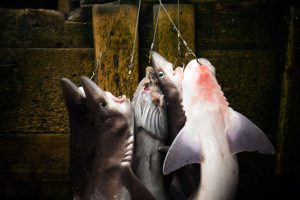
Wildlife
The great green shark hunt
Can British Columbia’s spiny dogfish make the grade as the world’s first “sustainable” shark fishery?
- 3319 words
- 14 minutes
Wildlife
Plus: Death metal singing bats, the lion of the microbial world, the dino heavyweights going club-to-club, and the accidentally introduced bee threatening native species.

A new study has shown that sand lance, a species of forage fish and food source to over 70 species, are not meant to swim the ocean blue. Conducted by researchers from the University of Connecticut, the study revealed that the sand lance — which populates the waters off New Jersey all the way north to Greenland — is divided into two genetically distinct groups. The break occurs on the Scotian Shelf, off the coast of Novoa Scotia. And, with no physical barrier present to explain such large differences in their genetic makeup, the answer may lie in the currents.
The two groups occupy current-divided waters that vary in temperature, which can mean life or death for sand lance that drift away from their home territory.
“When fish from the north reproduce and drift south, they are genetically less adapted to warmer southern waters, even if it’s five or six degrees warmer in the winter,” says UConn associate professor of marine sciences Hannes Baumann. “The realized connectivity is basically zero.”
This is the first opportunity scientists have had to document the genome of a sand lance and the findings shows the ocean is not as homogenous as people may think. Similar genetic divides have been documented in species including lobsters, scallops and cod, further demonstrating that temperature is an important survival factor. Barriers such as the one on the Scotian Shelf are expected to move north due to the effects of climate change — good news for southern populations, but potentially disastrous for northern populations.

A new study has found that bats have an impressive vocal range of seven octaves, far surpassing ours as humans, and even “growl” like death metal singers.
We’ve always known that bats produce high-pitch noises as echolocation rather than sight, but researchers made a surprising discovery when they filmed bats’ larynges for the first time. In addition to vibrating very thin membranes above their vocal folds, the research team discovered that another set of folds on their larynx vibrate as well, producing very low-frequency sounds.
Humans have similar vocal folds, however they only appear to be used by death metal and throat singers to make a throaty growl noise. Humans call these “false vocal folds” as they have no function in normal speech.
Researchers theorized that the false vocal folds of bats may have evolved this way because bats need to communicate over long distances and can do so more effectively with lower frequencies, while echolocation requires higher frequencies.
It’s unsure what the bats are communicating with these noises, but humans often hear them around bat roosts, and many have speculated that it could be associated with aggression or annoyance.

Researchers have discovered a new branch on the tree of life, and it’s made up of predators that nibble their prey to death.
The predators fall into two groups called nibblerids and nebulids, which together make up a new ancient branch on the tree of life called Provora. Nibberids nibble chunks off their prey using tooth-like structures, whereas nebulids eat their prey whole.
These microbial predators have been called the lions of the microbial world by the University of British Columbia researchers who published the study, due to being numerically rare yet important to their ecosystem.
On the tree of life sitting under domains, and above kingdoms, are branches of creatures called supergroups. The organisms in these groups share a common ancestor and are characterized by traits. The Provora branch is the latest supergroup to be discovered.
To discover the new microbes, researchers collected water samples from marine habitats across the globe. It was found that there were tiny organisms with two flagella or tails in the water that convulsed in place or swam very quickly. When these were present, almost all the others disappeared after just one or two days, leading to the conclusion that they were being eaten.

Which would win in a fight: an ankylosaur or… an ankylosaur? These armoured dinosaurs — resplendent with spikes along their flanks and a formidable club-like tail — were thought to have evolved their defensive weaponry to protect themselves from predators like tyrannosaurs. However, an exceptionally preserved specimen of ankylosaur Zuul crurivastator (from the Royal Ontario Museum’s collection) has paleontologists thinking these hench herbivores may have been battling something else… each other.
Detailed study of a fossil ankylosaur, led by Victoria Arbour of the Royal BC Museum, revealed that the spikes on its flanks had been broken and rehealed while the dinosaur was still alive. And the battle scars were consistent with the damage we’d expect from another Zuul’s tail club, suggesting that ankylosaurs used their tails to engage in ritualized combat for territory or mates.
While these armoured animals may well have used their tails to defend themselves from predators in a pinch, it’s likely their club-like tails evolved through sexual, rather than natural, selection — that is, tail clubs enabled better access to mates, like moose with big antlers.

Two new species of bee have been found in Canada for the first time — but the presence of one might be bad news for native mason bees.
Discovered by researchers at the University of Toronto Scarborough, the non-native mason bees originate from Northern Asia and were introduced to North America in the 1960s. Osmia cornifrons was brought over as a crop pollinator, but due to its similar appearance, Osmia taurus was accidentally co-introduced.
The presence of O. taurus is the most concerning, says lead study author Scott MacIvor. A recent study in the U.S. found an 800 per cent increase in O. taurus coincided with a 90 per cent decline in six different species of native mason bees. As of yet, there’s no evidence that O. cornifrons has had a negative effect on native bee populations.
The bees may have crossed the U.S.-Canada border, however they have only recently begun to appear north of the border. One explanation is the rise of bee hotels, used to support native bee populations in urban areas, which may be helping non-native bees to thrive. Another explanation is the online sale of bee cocoons, which may originate from the U.S.
MacIvor states that to support native species, focus on spring-flowering plants such as lupine, beardtongue, raspberry or redbud. “Build gardens with native flowering plants and pay attention and protect spots where nests develop naturally,” says MacIvor.
Are you passionate about Canadian geography?
You can support Canadian Geographic in 3 ways:

Wildlife
Can British Columbia’s spiny dogfish make the grade as the world’s first “sustainable” shark fishery?

People & Culture
A moratorium on cod fishing that was supposed to last two years has now lasted 30. What will it take to rebuild cod stocks — and a way of life?

History
From their beginnings in the late 19th century, salmon hatcheries have gone from cure to band-aid to crutch. Now, we can’t live without manufactured fish.

Environment
Currently only at 4.4 per cent, the province still needs to acquire another 2.6 per cent of land to protect by the end of 2020